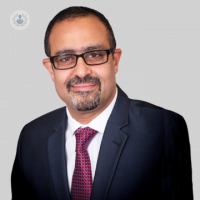An in-depth discussion on breast lift surgery: part 1
Written by:A breast lift/mastopexy is a procedure that many women choose to undergo if they become unhappy with the appearance of their breasts. In the first article of a two-part series, leading consultant plastic surgeon Mr Haitham Khashaba explains everything you need to know about the procedure.
What is the purpose of a breast lift?
The purpose of a breast lift, also known as mastopexy, is to reshape and raise the breasts to a more youthful and aesthetically pleasing position. It is a surgical procedure that addresses sagging or drooping breasts by removing excess skin and tightening the surrounding tissue to achieve a firmer and more lifted appearance.

Why would I consider a breast lift?
There are multiple factors which can contribute to the loss of breast firmness and shape. Some of these factors include pregnancy, breastfeeding, weight fluctuations, ageing, and genetics. Over time, the breasts may lose elasticity, resulting in sagging or a downward position of the nipples. A breast lift can address these concerns by:
Lifting and repositioning the breasts
The procedure involves removing excess skin and reshaping the breast tissue to lift the breasts to a higher position on the chest. This can restore a more youthful breast contour and improve symmetry
Reshaping the areolas
If the areolas have stretched or enlarged, a breast lift can reduce their size and reposition them to match the new breast shape.
Improving breast firmness
By removing excess skin and tightening the remaining tissue, a breast lift can enhance the firmness and tone of the breasts.
It's important to note that a breast lift does not significantly change the size of the breasts or provide a significant increase in upper pole fullness. However, the procedure can be combined with breast augmentation (implants) or reduction (tissue removal) surgery to achieve desired size or volume changes along with the lifting effect.
Before considering a breast lift or any surgical procedure, it's essential to consult with a qualified plastic surgeon who can assess your individual needs and provide personalised recommendations based on your anatomy and goals.
What is the best age to have a breast lift?
The ideal age to have a breast lift can vary depending on individual factors and circumstances. There isn't a specific "best" age for everyone, as each person's needs and desires are unique. The decision to undergo a breast lift is typically based on the physical characteristics and concerns of the individual rather than a specific age range.
The following factors are generally considered when determining if someone is a suitable candidate for a breast lift:
Breast sagging
The primary indication for a breast lift is sagging or drooping breasts. If your breasts have started to sag significantly and it affects your self-confidence or comfort, a breast lift may be appropriate.
Stability in breast development
It's generally recommended to wait until the breasts have fully developed before considering a breast lift. This ensures that the surgery will be effective in achieving long-lasting results. Breast development typically occurs by the late teens or early twenties, but individual variations exist.
Future pregnancy plans
If you plan to have children in the future, it may be advisable to postpone a breast lift until after completing your family. Pregnancy and breastfeeding can affect breast shape and firmness, potentially necessitating a revision surgery if done before having children.
General health and emotional readiness
Like any surgical procedure, a breast lift requires good overall health and emotional stability. It's important to be in a stable physical and mental condition to undergo the surgery and follow the post-operative recovery process.
Ultimately, the decision to have a breast lift should be made in consultation with a qualified plastic surgeon. They can evaluate your individual circumstances, assess your breast anatomy, discuss your goals, and recommend the most appropriate timing for the procedure. They will take into account your specific concerns, medical history, and personal preferences to provide personalised advice regarding the optimal age for a breast lift in your case.
What can I expect during the procedure?
During a breast lift procedure, you can generally expect the following:
Consultation and Preoperative Planning
You will have an initial consultation with a plastic surgeon to discuss your goals, medical history, and expectations. The surgeon will evaluate your breast anatomy, skin quality, and nipple position to determine the most appropriate surgical technique for you. They will provide preoperative instructions, which may include avoiding certain medications and arranging for someone to accompany you on the day of surgery.
Anesthesia
Breast lift surgery is typically performed under general anaesthesia, ensuring that you are comfortably asleep throughout the procedure.
Incision Placement
The specific incision pattern used will depend on the degree of breast sagging and the desired outcome. Common incision options include:
Anchor-shaped incision
This is the most common technique, involving incisions around the areola, vertically from the areola to the breast crease, and horizontally along the breast crease.
Lollipop incision
This technique involves incisions around the areola and vertically from the areola to the breast crease.
Donut incision
This technique involves a circular incision around the areola and is suitable for milder cases of sagging.
Reshaping and Repositioning
After the incisions are made, the surgeon will lift and reshape the breast tissue, repositioning the nipple and areola to a more elevated position. Excess skin will be removed to achieve a firmer and more youthful breast contour.
Areola and Nipple Adjustment
If necessary, the size and shape of the areola can be modified during the procedure to match the new breast appearance. This may involve reducing the diameter of the areola or repositioning it higher on the breast mound.
Once the desired reshaping and repositioning are achieved, the incisions are meticulously closed with sutures. The surgeon may use layered sutures in the breast tissue, and the skin may be closed with stitches, adhesive tape, or surgical glue.
After the surgery, you will be monitored in a recovery area as the anaesthesia wears off. You may have dressings or a surgical bra placed to support the breasts and aid in healing. You will receive instructions on post-operative care, including how to manage discomfort, incision care, medication usage, and when to schedule follow-up appointments.
It is important to note that every individual's experience and recovery can vary. Following your surgeon's post-operative instructions and attending scheduled follow-up visits are crucial for a smooth recovery and optimal results.
If you are considering a mastoplexy and would like to book a consultation with Mr Khashaba, simply visit his Top Doctors profile today.


